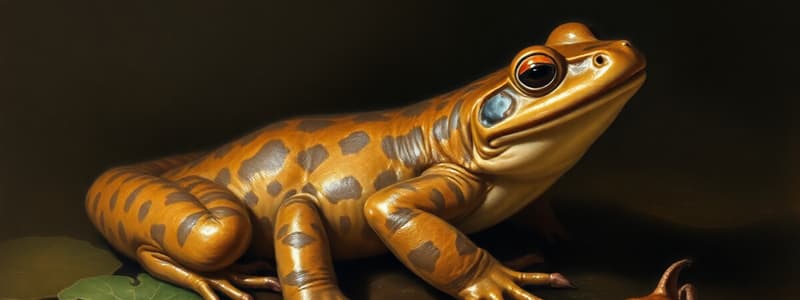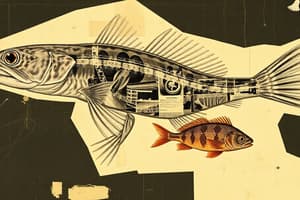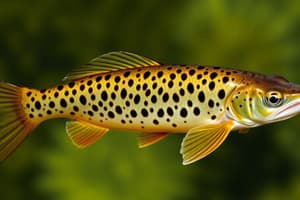Podcast
Questions and Answers
What type of fertilization do salamanders practice?
What type of fertilization do salamanders practice?
- Internal fertilization (correct)
- Parental care fertilization
- External fertilization
- Asexual reproduction
What is the primary role of amphibian skin?
What is the primary role of amphibian skin?
- Providing insulation
- Storage of fat reserves
- Gas exchange and osmotic balance (correct)
- Protection against predators
Which statement about frogs and toads is incorrect?
Which statement about frogs and toads is incorrect?
- Frogs mainly live in damp places. (correct)
- Toads prefer habitats away from water.
- Frogs have specialized hind limbs for jumping.
- They are tailless as adults.
What unique feature do reptile eggs have?
What unique feature do reptile eggs have?
How do amphibians commonly reproduce?
How do amphibians commonly reproduce?
What adaptation do amphibian ears have?
What adaptation do amphibian ears have?
What is the primary function of the amnion in reptile eggs?
What is the primary function of the amnion in reptile eggs?
What physiological process do amphibians use to respire?
What physiological process do amphibians use to respire?
What is the primary function of the notochord in chordates?
What is the primary function of the notochord in chordates?
During embryonic development, which structures in vertebrates have a role in gas exchange?
During embryonic development, which structures in vertebrates have a role in gas exchange?
Which statement about the dorsal hollow nerve cord is true?
Which statement about the dorsal hollow nerve cord is true?
In which of the following groups does the notochord persist throughout life?
In which of the following groups does the notochord persist throughout life?
What is a defining feature of urochordates during their larval stage?
What is a defining feature of urochordates during their larval stage?
Which characteristic allows lancelets to filter feed effectively?
Which characteristic allows lancelets to filter feed effectively?
How do adult tunicates engage with their environment?
How do adult tunicates engage with their environment?
What happens to pharyngeal pouches in terrestrial vertebrates?
What happens to pharyngeal pouches in terrestrial vertebrates?
What are the chief characteristics of mammals?
What are the chief characteristics of mammals?
How do mammals primarily regulate their body temperature?
How do mammals primarily regulate their body temperature?
Which statement about the gas exchange in mammals is correct?
Which statement about the gas exchange in mammals is correct?
What allows mammals to care for their young without leaving them to find food?
What allows mammals to care for their young without leaving them to find food?
Which type of mammals lay eggs?
Which type of mammals lay eggs?
Where do marsupials primarily continue their development after birth?
Where do marsupials primarily continue their development after birth?
What is the function of the placenta in placental mammals?
What is the function of the placenta in placental mammals?
Which trait is commonly associated with placental mammals?
Which trait is commonly associated with placental mammals?
Which order includes animals such as horses, zebras, tapirs, and rhinoceroses?
Which order includes animals such as horses, zebras, tapirs, and rhinoceroses?
What characteristic distinguishes the order Carnivora?
What characteristic distinguishes the order Carnivora?
Which mammals are classified in the order Chiroptera?
Which mammals are classified in the order Chiroptera?
What feature is common among members of the order Rodentia?
What feature is common among members of the order Rodentia?
What is a notable feature of the order Cetacea?
What is a notable feature of the order Cetacea?
Which of the following is true about the order Primates?
Which of the following is true about the order Primates?
Which order includes animals like rabbits, hares, and pikas?
Which order includes animals like rabbits, hares, and pikas?
What is a defining feature of elephants in the order Proboscidea?
What is a defining feature of elephants in the order Proboscidea?
How many gill slits do sharks typically have on each side of their pharynx?
How many gill slits do sharks typically have on each side of their pharynx?
What structure covers the gills of bony fishes?
What structure covers the gills of bony fishes?
What type of scales cover the bodies of sharks?
What type of scales cover the bodies of sharks?
What is one of the primary feeding strategies of whale sharks?
What is one of the primary feeding strategies of whale sharks?
How do most fish fertilize their eggs?
How do most fish fertilize their eggs?
What major characteristic distinguishes amphibians from other vertebrates?
What major characteristic distinguishes amphibians from other vertebrates?
Which of the following is NOT a group of modern amphibians?
Which of the following is NOT a group of modern amphibians?
Which type of fins are primarily found in bony fishes?
Which type of fins are primarily found in bony fishes?
How many species of reptiles are in the class Reptilia?
How many species of reptiles are in the class Reptilia?
From which group did reptiles evolve?
From which group did reptiles evolve?
Which of the following reptiles returned to aquatic environments?
Which of the following reptiles returned to aquatic environments?
What significant feature helps pterosaurs in flight?
What significant feature helps pterosaurs in flight?
What does the impact theory of dinosaur extinction suggest caused the extinction?
What does the impact theory of dinosaur extinction suggest caused the extinction?
What is a characteristic of turtles?
What is a characteristic of turtles?
Which adaptation do snakes have for consuming large prey?
Which adaptation do snakes have for consuming large prey?
What type of skin do reptiles have?
What type of skin do reptiles have?
Flashcards
What is a notochord?
What is a notochord?
A supporting rod located dorsally just below the nerve cord, often replaced by a vertebral column in vertebrates.
What is a dorsal hollow nerve cord?
What is a dorsal hollow nerve cord?
A fluid-filled canal located on the dorsal side of the body, forming the spinal cord in vertebrates.
What are pharyngeal pouches?
What are pharyngeal pouches?
Openings in the pharynx that function in feeding, gas exchange, or both. They are present in embryos and modified for different purposes in various vertebrates.
What is a post-anal tail?
What is a post-anal tail?
Signup and view all the flashcards
What are invertebrate chordates?
What are invertebrate chordates?
Signup and view all the flashcards
What are cephalochordates?
What are cephalochordates?
Signup and view all the flashcards
What are urochordates?
What are urochordates?
Signup and view all the flashcards
What is a tunicate larva?
What is a tunicate larva?
Signup and view all the flashcards
Shark teeth replacement
Shark teeth replacement
Signup and view all the flashcards
Class Chondrichthyes
Class Chondrichthyes
Signup and view all the flashcards
Swim bladder
Swim bladder
Signup and view all the flashcards
Ray-finned fish
Ray-finned fish
Signup and view all the flashcards
Operculum
Operculum
Signup and view all the flashcards
Class Amphibia
Class Amphibia
Signup and view all the flashcards
Age of Amphibians
Age of Amphibians
Signup and view all the flashcards
Frogs and toads
Frogs and toads
Signup and view all the flashcards
Mammals
Mammals
Signup and view all the flashcards
Monotremes
Monotremes
Signup and view all the flashcards
Marsupials
Marsupials
Signup and view all the flashcards
Placental mammals
Placental mammals
Signup and view all the flashcards
Hair in mammals
Hair in mammals
Signup and view all the flashcards
Mammary glands
Mammary glands
Signup and view all the flashcards
Circulatory system in mammals
Circulatory system in mammals
Signup and view all the flashcards
Importance of placenta
Importance of placenta
Signup and view all the flashcards
Amphibian Heart
Amphibian Heart
Signup and view all the flashcards
Amphibian Skin
Amphibian Skin
Signup and view all the flashcards
Salamander and Newt Diet
Salamander and Newt Diet
Signup and view all the flashcards
Amphibian Tongue
Amphibian Tongue
Signup and view all the flashcards
Amphibian Eyelids
Amphibian Eyelids
Signup and view all the flashcards
Amphibian Eggs
Amphibian Eggs
Signup and view all the flashcards
Caecilians
Caecilians
Signup and view all the flashcards
When did reptiles evolve?
When did reptiles evolve?
Signup and view all the flashcards
What were pelycosaurs?
What were pelycosaurs?
Signup and view all the flashcards
What were Ichthyosaurs and Plesiosaurs?
What were Ichthyosaurs and Plesiosaurs?
Signup and view all the flashcards
What were Pterosaurs?
What were Pterosaurs?
Signup and view all the flashcards
What were dinosaurs?
What were dinosaurs?
Signup and view all the flashcards
What is the impact theory?
What is the impact theory?
Signup and view all the flashcards
What evidence supports the impact theory?
What evidence supports the impact theory?
Signup and view all the flashcards
What are the characteristics of reptile skin?
What are the characteristics of reptile skin?
Signup and view all the flashcards
What are Perissodactyla and Artiodactyla?
What are Perissodactyla and Artiodactyla?
Signup and view all the flashcards
What is the Carnivora order?
What is the Carnivora order?
Signup and view all the flashcards
What is the Primate order?
What is the Primate order?
Signup and view all the flashcards
What is the Cetacea order?
What is the Cetacea order?
Signup and view all the flashcards
What is the Chiroptera order?
What is the Chiroptera order?
Signup and view all the flashcards
What is the Rodentia order?
What is the Rodentia order?
Signup and view all the flashcards
What is the Proboscidea order?
What is the Proboscidea order?
Signup and view all the flashcards
What is the Lagomorpha order?
What is the Lagomorpha order?
Signup and view all the flashcards
Study Notes
Phylum: Chordata
- Chordates include 45,000 species.
- All chordates have four basic characteristics at some point in their life.
- Notochord: A supporting rod located dorsally just below the nerve cord, replaced by the vertebral column in vertebrates.
- Dorsal hollow nerve cord: Contains a fluid-filled canal. In vertebrates, it's the spinal cord.
- Pharyngeal pouches: Openings that can function in feeding or gas exchange. In invertebrate chordates, fish, and amphibian larvae, they become functioning gills; in terrestrial vertebrates, they are modified for other purposes.
- Post-anal tail: Extends beyond the anal opening, present in some embryos.
1- Subphylum: Invertebrata
- Invertebrate Chordates:
- Notochord persists and is never replaced by a vertebral column.
- Cephalochordata (Lancelets):
- About 23 species in genus Branchiostoma.
- Elongated, lance-shaped body resembling a two-edged surgical knife.
- Inhabit shallow coastal waters.
- Filter feeders, partly buried in sandy substrates.
- Feed on microscopic particles filtered from water that enters the mouth and exits through gill openings.
2- Subphylum: Vertebrata
- Vertebrate Chordates
- 43,700 species.
- Have all four chordate characteristics at some point in their lives.
- Embryonic notochord replaced by a vertebral column.
- Vertebral column supports dorsal hollow nerve cord.
- Skeleton (cartilage or bone) is a vital tissue that grows with the animal. Muscles support efficient movement.
- Skull enclosed the brain.
- Complex sense organs (eyes, ears).
- Complete digestive system with a large coelom
- Closed circulatory system (blood contained in vessels)
- Efficient gas exchange: via gills or lungs.
- Kidneys excrete waste and regulate water.
- Reproduction: Usually sexual, with separate sexes.
I. Fishes
- Aquatic gill-breathing vertebrates typically with fins and scaled skin. Used to be filter feeders, now able to move water through gills via muscular action.
-
Class: Cyclostomata (Jawless Fishes):
- 63 species: lampreys and hagfish).
- Smooth, non-scaly skin.
- Cylindrical bodies (up to a meter long).
- Hagfish are scavengers, feeding on invertebrates or dead fish.
- Lampreys are filter feeders or parasites, attaching to fish and sucking nutrients.
-
Class: Chondrichthyes (Fishes with Jaws):
- 850 species (sharks, rays, and skates)
- Cartilaginous skeleton (not bone).
- Five to seven gill slits.
- Scaled skin.
- Teeth are enlarged scales in rows.
-
Class: Osteichthyes (Bony Fishes):
- 20,000+ species (salmon, trout, eels)
- Bony skeleton.
- Ray-finned with thin bony rays supporting fins.
- Skin covered in scales.
- Gills covered by operculum.
- Swim bladder for buoyancy control.
- Reproduction: Eggs usually shed into water, with fertilization and development outside the mother's body.
-
II. Amphibians
- Tetrapods with four limbs; adapted for both land and water.
- Groups: frogs & toads, salamanders & newts, and caecilians.
- Salamanders & newts: long bodies, tails; carnivorous, internal fertilization.
- Frogs & toads: tailless; specialized hind limbs for jumping; aquatic or moist places; carnivorous.
- Caecilians: legless; burrow in soil; feed on worms.
- Reproduction: returns to water, external fertilization, tadpoles metamorphose.
- Ectothermic (regulate body temperature by environment)
III. Reptiles
- Internal fertilization. Leathery-shell eggs (amnions).
- Groups: pelycosaurs, ichthyosaurs, pterosaurs, dinosaurs, lizards, snakes, turtles, crocodiles
- Internal fertilization, amniotic egg (leathery shell).
- Some evolved to live in water, fly, or other varied habitats
- Some lizards, snakes (with venom), turtles, crocodiles and alligators.
- Ectotherms (regulate body temperature by environment)
IV. Birds
- Scales, lack teeth.
- Adaptations for flight: Air sacs, bones, respiratory system.
- Endothermic (regulate body temperature)
V. Mammals
- Mammary glands; hair.
- Monotremes: Lay eggs (duck-billed platypus, spiny anteater)
- Marsupials: Pouch for newborns (kangaroos, opossums)
- Placental mammals: Placenta for nourishment.
- Classification: Based on locomotion and feeding.
Studying That Suits You
Use AI to generate personalized quizzes and flashcards to suit your learning preferences.




